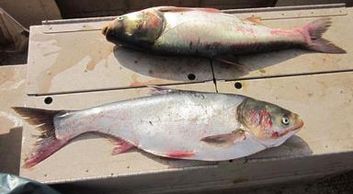Aquatic Invasive Species
Aquatic invasive species (AIS) are a serious threat to Door County’s waterways and wetlands. Whether they are moved in ballast water, recreational boats, or in the water of a livewell or bait bucket, many non-native animals such as the spiny waterflea continue to spread throughout Wisconsin and the Midwest. These animals can cause severe damage to local ecosystems, industry and tourism. In addition, invasive aquatic plants are one of the greatest threats to the long-term health of our wetlands. Reed canary grass currently dominates almost half a million of Wisconsin’s wetland acres and Phragmites has been expanding westward through Wisconsin from the Lake Michigan shoreline. DCIST has created the following list of aquatic plants and animals that threaten Door County’s natural environments and economy. A summary of the “Top 15” Invasive Plants in Door County (with pictures) can be found at the bottom of this page.
You can help prevent the spread of AIS in our waters and wetlands by doing the following:
- INSPECT boats, trailers and equipment
- REMOVE any attached aquatic plants or animals before and after each use
- DRAIN all water from boats, motors, and equipment
- NEVER MOVE live fish away from a waterbody
- Know the bait laws and DISPOSE of unwanted bait in the trash.
- If possible, DECONTAMINATE equipment (e.g. boat washing station)
For more steps to slow the spread of invasive species, visit the Wisconsin DNR’s Prevention Page.
Aquatic & Wetland Invasive Species to Know
Eurasian Water-Milfoil
Eurasian Water-Milfoil
Eurasian Water-Milfoil

Myriophyllum spicatum
View More Photos - Explore Facts
Learn How to Control
Photo: Paul Skawinski, UW-Extension Lakes
Curly-Leaved Pondweed
Eurasian Water-Milfoil
Eurasian Water-Milfoil

Potamogeton crispus
View More Photos - Explore Facts
Learn How to Control
Photo: Leslie J. Mehrhoff, University of Connecticut, Bugwood.org
Starry Stonewort
Eurasian Water-Milfoil
Starry Stonewort

Nitellopsis obtusa
View More Photos - Explore Facts
Photo: Paul Skawinski, UW-Extension Lakes
Round Goby
Starry Stonewort

Neogobius melanostomus
View More Photos - Explore Facts
Prevent their Spread
Photo: Paul Skawinski, UW-Extension Lakes
Rusty Crayfish

Orconectes rusticus
View More Photos - Explore Facts
Prevent their Spread
Photo: U.S. Geological Survey , U.S. Geological Survey, Bugwood.org
Bighead & Silver Carp

Hypophthalmichthys nobilis and H. molitrix
View Bighead Photos - View Silver Photos
Explore Facts - Prevent their Spread
Photo: Lindsey Lewis, U.S. Fish and Wildlife, Bugwood.org
Zebra Mussels

Dreissena polymorpha
View More Photos - Explore Facts
Photo: Randy Westbrooks, Invasive Plant Control, Inc., Bugwood.org
Quagga Mussels

White Perch
Spiny & Fishhook Waterfleas

Morone americana
View More Photos - Explore Facts
Photo: Nate Tessler, EnviroScience, Inc., Bugwood.org
Spiny & Fishhook Waterfleas
Spiny & Fishhook Waterfleas
Spiny & Fishhook Waterfleas

Bythotrephes cederstroemi &
Cercopagis pengoi
View More Photos - Spiny Facts
Fishhook Facts - Prevent their Spread
cPhoto: Gary Montz, 144, Bugwood.org
Common Reed (Phragmites)
Spiny & Fishhook Waterfleas
Common Reed (Phragmites)

Phragmites australis
View More Photos - Facts & Identification
Control Guide - DCIST Factsheet
Photo: Paul Skawinski, UW-Extension Lakes
European Marsh Thistle
Spiny & Fishhook Waterfleas
Common Reed (Phragmites)

Japanese Knotweed
Purple Loosestrife
Purple Loosestrife

Polygonum cuspidatum
View More Photos - Explore Facts
Control Recommendations - More Control DCIST Factsheet
Photo: Kari Hagenow, The Nature Conservancy
Purple Loosestrife
Purple Loosestrife
Purple Loosestrife

Lythrum salicaria
View More Photos - Explore Facts
Control Recommendations
Photo: Paul Skawinski, UW-Extension Lakes
Reed Canary Grass
Purple Loosestrife
Narrow-Leaved Cattail

Phalaris arundinacea
View More Photos - Explore Facts
Control Recommendations
Photo: Kari Hagenow, The Nature Conservancy
Narrow-Leaved Cattail
Narrow-Leaved Cattail

Typha angustifolia
View More Photos - Explore Facts
Control Recommendations
Photo: Mandy Tu, The Nature Conservancy, Bugwood.org
Flowering Rush

Butomus umbellatus
View More Photos - Explore Facts
Control Recommendations
Photo: Leslie J. Mehrhoff, University of Connecticut, Bugwood.org
Yellow Water-Flag Iris

Iris pseudacorus
View More Photos - Explore Facts
Control Recommendations
Photo: John M. Randall, The Nature Conservancy, Bugwood.org
Lyme Grass
Glossy Buckthorn
Canada Thistle

Leymus arenarius
View More Photos - Explore Facts
Control Recommendations
Photo: Nisa Karimi, Wisconsin Department of Natural Resources, Bugwood.org
Canada Thistle
Glossy Buckthorn
Canada Thistle

Cirsium arvense
View More Photos - Identification Video
Explore Facts
Control Recommendations
Photo: Jan Samanek, Phytosanitary Administration, Bugwood.org
Glossy Buckthorn
Glossy Buckthorn
Glossy Buckthorn

Frangula alnus
View More Photos - Explore Facts
Control Recommendations
Photo: Rob Routledge, Sault College, Bugwood.org
